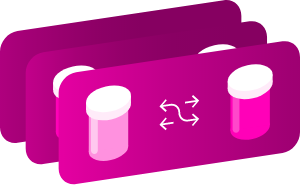This drug entry is astuband has not been fully annotated. It is scheduled to be annotated soon.
Identification
- Generic Name
- Carbarsone
- DrugBank Accession Number
- DB11382
- Background
-
Carbarsone is a compound used as an antiprotozoal drug for the treatment of histomoniasis (or blackhead disease) in addition to other infectious diseases in chicken and turkeys. It belongs to theorganoarsenicgroup of chemical compounds and has antiamebic properties. It is also used as a food additive with the goal of increasing weight gain and controlling the occurrence of blackhead disease in chicken and turkeys.
- Type
- Small Molecule
- Groups
- Vet approved
- Structure
- Weight
-
Average: 260.079
Monoisotopic: 259.977828203 - Chemical Formula
- C7H9AsN2O4
- Synonyms
-
- Carbarson
- Carbarsone
- Carbarsonum
- Pentarsone
- Phenarsone
Pharmacology
- Indication
-
Not Available
 Reduce drug development failure ratesBuild, train, & validate machine-learning models
Reduce drug development failure ratesBuild, train, & validate machine-learning models
with evidence-based and structured datasets.Build, train, & validate predictive machine-learning models with structured datasets. - Contraindications & Blackbox Warnings
-
 Avoid life-threatening adverse drug eventsImprove clinical decision support with information oncontraindications & blackbox warnings, population restrictions, harmful risks, & more.Avoid life-threatening adverse drug events & improve clinical decision support.
Avoid life-threatening adverse drug eventsImprove clinical decision support with information oncontraindications & blackbox warnings, population restrictions, harmful risks, & more.Avoid life-threatening adverse drug events & improve clinical decision support. - Pharmacodynamics
-
Not Available
- Mechanism of action
- Not Available
- Absorption
-
Not Available
- Volume of distribution
-
Not Available
- Protein binding
-
Not Available
- Metabolism
- Not Available
- Route of elimination
-
Not Available
- Half-life
-
Not Available
- Clearance
-
Not Available
- Adverse Effects
-
 Improve decision support & research outcomesWith structured adverse effects data, including:blackbox warnings, adverse reactions, warning & precautions, & incidence rates.Improve decision support & research outcomes with our structured adverse effects data.
Improve decision support & research outcomesWith structured adverse effects data, including:blackbox warnings, adverse reactions, warning & precautions, & incidence rates.Improve decision support & research outcomes with our structured adverse effects data. - Toxicity
-
Not Available
- Pathways
- Not Available
- Pharmacogenomic Effects/ADRsBrowse all" title="" id="snp-actions-info" class="drug-info-popup" href="javascript:void(0);">
- Not Available
Interactions
- Drug InteractionsLearn More" title="" id="structured-interactions-info" class="drug-info-popup" href="javascript:void(0);">
-
This information should not be interpreted without the help of a healthcare provider. If you believe you are experiencing an interaction, contact a healthcare provider immediately. The absence of an interaction does not necessarily mean no interactions exist.Not Available
- Food Interactions
- Not Available
Categories
- Drug Categories
- Chemical TaxonomyProvided byClassyfire
-
- Description
- This compound belongs to the class of organic compounds known as n-phenylureas. These are compounds containing a N-phenylurea moiety, which is structurally characterized by a phenyl group linked to one nitrogen atom of a urea group.
- Kingdom
- Organic compounds
- Super Class
- Benzenoids
- Class
- Benzene and substituted derivatives
- Sub Class
- N-phenylureas
- Direct Parent
- N-phenylureas
- Alternative Parents
- Pentaorganoarsanes/Ureas/Oxygen-containing organoarsenic compounds/Organic metalloid salts/Organopnictogen compounds/Organonitrogen compounds/Organic oxides/Hydrocarbon derivatives/Carbonyl compounds
- Substituents
- Aromatic homomonocyclic compound/Carbonic acid derivative/Carbonyl group/Hydrocarbon derivative/N-phenylurea/Organic metalloid salt/Organic nitrogen compound/Organic oxide/Organic oxygen compound/Organic salt
- Molecular Framework
- Aromatic homomonocyclic compounds
- External Descriptors
- Not Available
- Affected organisms
- Not Available
Chemical Identifiers
- UNII
- 8PK70TXE1T
- CAS number
- 121-59-5
- InChI Key
- WWXBHTZSYYGCSG-UHFFFAOYSA-N
- InChI
-
InChI=1S/C7H9AsN2O4/c9-7(11)10-6-3-1-5(2-4-6)8(12,13)14/h1-4H,(H3,9,10,11)(H2,12,13,14)
- IUPAC Name
-
[4-(carbamoylamino)phenyl]arsonic acid
- SMILES
-
NC(=O)NC1=CC=C(C=C1)[As](O)(O)=O
References
- 一般References
-
- Authors unspecified: CARBARSONE. Bull Am Pharm Assoc. 1946 Mar-Apr;14:76. [Article]
- GREEN MW: Acetarsone, carbarsone and iodochlorohydroxyquinoline. J Am Pharm Assoc Am Pharm Assoc (Baltim). 1946 Apr;7:150-2. [Article]
- Authors unspecified: The determination of carbarsone in animal feeds. Analyst. 1971 Nov;96(148):817-23. [Article]
- ALBORNOZ PLATA A: [Erythromycin-carbarsone in the treatment of amebiasis]. Rev Fac Med Univ Nac Colomb. 1959 Oct-Dec;27:235-44. [Article]
- SHERSHIN PH, DAVIS VT: Toxicity of carbarsone as an anti-amebic. J Med Soc N J. 1957 Jul;54(7):322-3. [Article]
- GREEN MW: The use of acetarsone, carbarsone, and iodochlorohydroxyquinoline. Bull Am Pharm Assoc. 1946 Mar-Apr;14:75-80. [Article]
- NELSON RS: Hepatitis due to carbarsone; report of two cases. J Am Med Assoc. 1956 Mar 3;160(9):764-6. [Article]
- LITTLE RP: Carbarsone in the treatment of pemphigus; a preliminary report. Arch Derm Syphilol. 1945 Nov-Dec;52:397. [Article]
- CONN HC, FELDMAN PW: Treatment of amebiasis. Results with diodoquin and carbarsone. Postgrad Med. 1951 Feb;9(2):137-40. [Article]
- RADKE RA: Treatment of amebiasis with atabrine combined with carbarsone. Ann Intern Med. 1951 Jun;34(6):1432-44. [Article]
- External Links
-
- ChemSpider
- 8167
- 20206
- ChEBI
- 94806
- ChEMBL
- CHEMBL1331366
- Wikipedia
- Carbarsone
Clinical Trials
- Clinical TrialsLearn More" title="" id="clinical-trials-info" class="drug-info-popup" href="javascript:void(0);">
-
Phase Status Purpose Conditions Count
Pharmacoeconomics
- Manufacturers
-
Not Available
- Packagers
-
Not Available
- Dosage Forms
- Not Available
- Prices
- Not Available
- Patents
- Not Available
Properties
- State
- Not Available
- Experimental Properties
- Not Available
- Predicted Properties
-
Property Value Source Water Solubility 3.08 mg/mL ALOGPS logP -0.39 ALOGPS logP -0.017 Chemaxon logS -1.9 ALOGPS pKa (Strongest Acidic) 3.5 Chemaxon pKa (Strongest Basic) -3.7 Chemaxon Physiological Charge -1 Chemaxon Hydrogen Acceptor Count 4 Chemaxon Hydrogen Donor Count 4 Chemaxon Polar Surface Area 112.65 Å2 Chemaxon Rotatable Bond Count 2 Chemaxon Refractivity 45.59 m3·mol-1 Chemaxon Polarizability 19.99 Å3 Chemaxon Number of Rings 1 Chemaxon Bioavailability 1 Chemaxon Rule of Five Yes Chemaxon Ghose Filter Yes Chemaxon Veber's Rule No Chemaxon MDDR-like Rule No Chemaxon - Predicted ADMET Features
- Not Available
Spectra
- Mass Spec (NIST)
- Not Available
- Spectra
-
Spectrum Spectrum Type Splash Key Predicted MS/MS Spectrum - 10V, Positive (Annotated) Predicted LC-MS/MS Not Available Predicted MS/MS Spectrum - 20V, Positive (Annotated) Predicted LC-MS/MS Not Available Predicted MS/MS Spectrum - 40V, Positive (Annotated) Predicted LC-MS/MS Not Available Predicted MS/MS Spectrum - 10V, Negative (Annotated) Predicted LC-MS/MS Not Available Predicted MS/MS Spectrum - 20V, Negative (Annotated) Predicted LC-MS/MS Not Available Predicted MS/MS Spectrum - 40V, Negative (Annotated) Predicted LC-MS/MS Not Available
Drug created at February 25, 2016 18:17 / Updated at February 21, 2021 18:53



